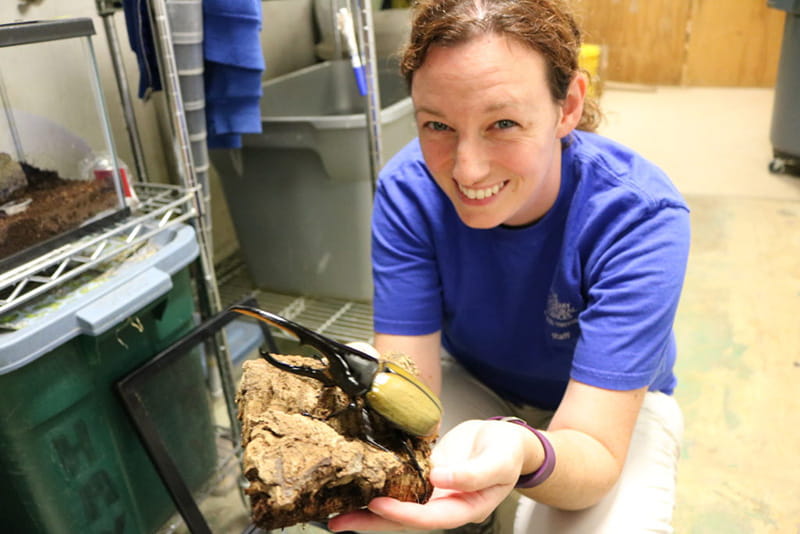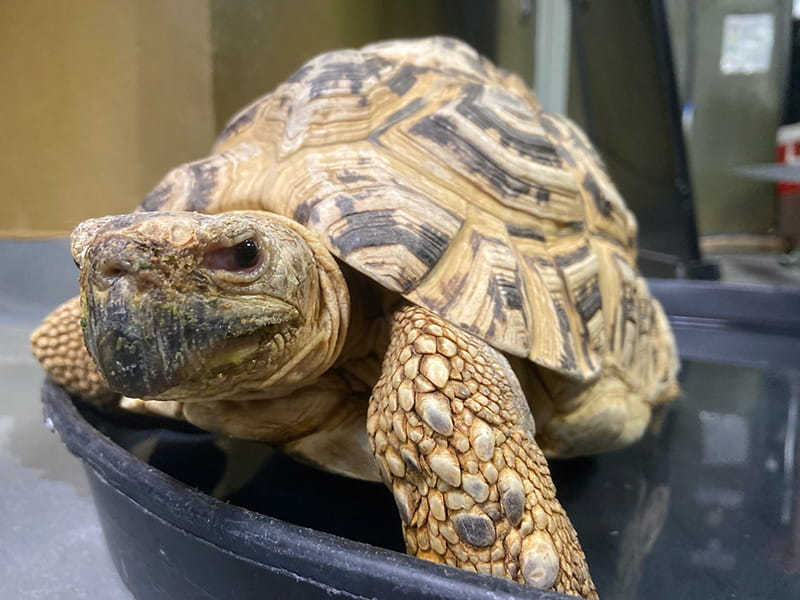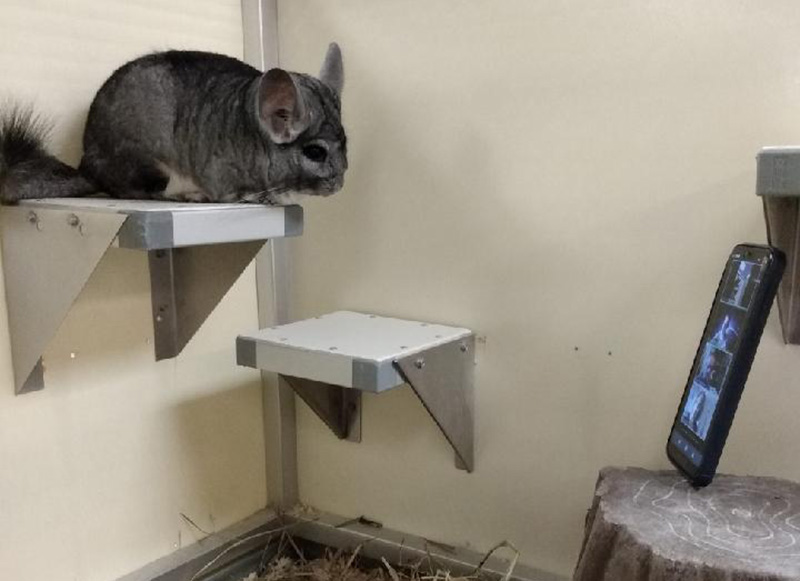Animal House: How Academy Animals and Handlers Are Sheltering in Place During COVID-19

Many members of the Drexel University community brought home items from campus to ease their transition into working or learning from home in light of the COVID-19 pandemic.
For Karen Verderame, animal programs developer for the Academy of Natural Sciences at Drexel University (ANS), this transition into working from home required a different kind of campus transfer: bringing home several colonies of hissing cockroaches, as well as a couple of testy tarantulas, and some centipedes will also make their way to her in-home bug room sometime this week.
For Karen Verderame, animal programs developer for the Academy of Natural Sciences at Drexel University (ANS), this transition into working from home required a different kind of campus transfer: bringing home several colonies of hissing cockroaches, as well as a couple of testy tarantulas, and some centipedes will also make their way to her in-home bug room sometime this week.
This includes: 14 snakes, 13 turtles and tortoises, 10 lizards, three frogs, five rabbits, three armadillos, two guinea pigs, two ducks, two turkey vultures, one chinchilla, numerous live invertebrates and a variety of fish usually kept by Academy scientists.
“I have some of them here at the house to alleviate time on the staff in the building,” Verderame said of the invertebrates she decided to take home (with USDA awareness and permission). “But I’m trying to be mindful of the things I bring home, that they are things I can still manage if I happen to get sick, or my family can help manage if I were to get sick. My daughter has grown up with this, so she actually knows how to care for the hissing cockroaches. So, God forbid if something should happen to me, she will [be tasked with] the cockroaches. … It’s not really anything new for my family.”
What has been new for Verderame and her team have been the necessary planning, precautions and unpreventable hardships they have overcome through working with these live animals at the Academy while the world outside is in crisis. Here’s a look at what’s come up in the past, what a day of care in the present is like, and how Verderame is looking at for the future of those under her care.
Past
“Once the shutdown was initiated, we went into complete triage mode,” Verderame said of March 13. Her immediate task within the next 24 hours was to complete a contingency plan that outlined vital information like who could be deemed essential personnel to still venture to the Academy and complete animal care, what safety measures should be put in place for both humans and animals, what the work schedule would look like and what care-level protocols they would stick to in a variety of situations, among many others.
“So, that’s kind of how that first week played out. It was just a lot of triage getting contingency plans in place, protocols in place, modifying our daily husbandry needs to the limited staff that we had and caring for the collection that was found throughout the building,” she said. “Each week, then, it has been evolving those contingency plans and protocols to face the unknown.”
And in facing the unknown and these transitions, the animals did not necessarily make things easy for Verderame and her staff.

On March 12, before the shutdown was even announced, there was a scuffle in the turtle tank where one turtle’s eye was injured after its face was bitten.
“Eye injuries are serious business and need not to be taken lightly. You need to be on top of it. It was right at the start of all the chaos, and I was also losing my reptile keeper because he was already scheduled off to be married,” Verderame remembered. “But a colleague actually took home the turtle to nurse it, making sure it was getting all the medicine it needed and the direct attention that it needed since it was going to be chaos with staffing. … She did a great job. She has a future being a nurse for turtles.”
Then, on March 14, another sad surprise. Verderame got to the Academy for her animal care shift to discover one of their older species — an opossum named Branch — was lethargic. She rushed him to the vet, where she found out he had cancer and was deteriorating, so she made the tough decision to euthanize the animal.

Additional hijinks included the armadillos digging a hole in their enclosure, prompting Verderame to have to completely redo it. Despite what one may think, this was not an emotional response to the changes happening around them. Verderame said it’s just something they do, pandemic or not.
Also, a snake had shed its skin, but the eye cap — or the scale over the eye — got stuck. This created a tough situation for the staff in terms of caring for the animal but maintaining social distancing.
“Just like in a hospital, there are times where you can’t be six feet away from each other,” she said. “We have this snake that could be caused serious harm because of his eye cap, so somebody has to restrain the snake while somebody else is trying to rub the eye cap off. That’s why we have protocols in place for when we have to work together like that.”
Present
Situations like working in close proximity to resolve the snake’s eye issue are definitely not the norm for Verderame and her staff as they continue to care for the animals through COVID-19.
In fact, their contingency plan puts in place parameters to ensure each worker is assigned a designated animal population and area to work in, limiting contact with others. There are also never more than three animal care staff present in the building at one time.
Their plan also outlines several different levels of appropriate care for the animals, which allows for the possibility that some essential staff might be unable to come into work at times. These levels range from one to three. A level one care day, Verderame explained, is the normal, optimal care she and her team were doing prior to the shutdown, the only difference being these enhanced social distancing procedures. Verderame can carry out a level one care day on her own due to her level of training, but there are certainly several situations that can impede on such plans (remember the snake and armadillo high jinks?).
Therefore, dropping down to a level two care day includes spot-cleaning animal enclosures as opposed to completely breaking down and disinfecting them, as well as replacing items like wood chips and hay and replenishing food and water. This can some in especially handy if and when full-time keepers can’t come in, and partially trained staff not up-to-speed on all the different cleaning measures could carry this out in a workday.
“And then we have our level three care day, which means basic needs are met,” Verderame continued, “meaning the things that need to be fed are fed, and everybody is checked for water. That is what we would normal do on something like a holiday, like Christmas, New Year’s Day or Thanksgiving Day. … So, somebody came in and just did the basic needs.”
This would be the case if very limited staff were available, and who knows if or when this could ever be the case.
“You’re just constantly rolling with the flow,” Verderame said of the approach at this time. “You’re just taking it as it comes and you adapt, just like the creatures you’re caring for.”
Future

Thankfully, this outlook for herself and her staff and the animals she tends to is pretty good at the moment, Verderame said. There has been minimal disruption in terms of the facility and their supply chain, save for a lost shipment of fruit flies and the one day that the lights weren’t working throughout the museum.
They have some of the same concerns about obtaining the personal protective equipment needed to maintain their new protocols, but thankfully some Academy scientists donated a stockpile of gloves that they were able to tap into, and some crafters associated with the Academy will be sewing the staff some masks to back up their current supply.
But like many others, there is the dearth of one product that’s starting to get a little worrisome.
“It’s getting scary with paper towels,” Verderame said. “It’s really hard to find them right now.”
But all-in-all, Verderame and her staff are still thinking and planning ahead. They’re stocking up on wood chips from their supplier in New Jersey, and overshooting their order of frozen mice and rats that become food for snakes and vultures. They’re looking ahead to opening back up to the public, and hopefully even bringing back the animals from the Survival of the Slowest exhibit, including Lulu the sloth. The animals were temporarily relocated to a nature center in Canada with more staffing.
“We just keep going,” Verderame said.
In This Article
Drexel News is produced by
University Marketing and Communications.
